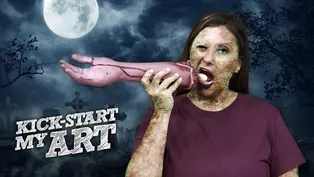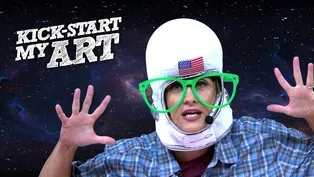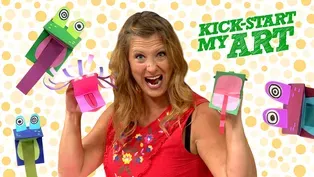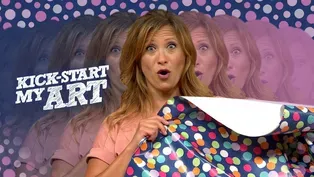
3D Art
Special | 5m 44sVideo has Closed Captions
Discover the secrets behind creating 3D art.
Discover the secrets behind creating 3D art, all while having a blast with this playful balloon dog project. This fun and engaging project will help you understand the power of shading and highlights to give your artwork depth and dimension. Let's dive in and unleash the artist within you!
Problems with Closed Captions? Closed Captioning Feedback
Problems with Closed Captions? Closed Captioning Feedback
WKAR Family is a local public television program presented by WKAR

3D Art
Special | 5m 44sVideo has Closed Captions
Discover the secrets behind creating 3D art, all while having a blast with this playful balloon dog project. This fun and engaging project will help you understand the power of shading and highlights to give your artwork depth and dimension. Let's dive in and unleash the artist within you!
Problems with Closed Captions? Closed Captioning Feedback
How to Watch WKAR Family
WKAR Family is available to stream on pbs.org and the free PBS App, available on iPhone, Apple TV, Android TV, Android smartphones, Amazon Fire TV, Amazon Fire Tablet, Roku, Samsung Smart TV, and Vizio.
More from This Collection
Video has Closed Captions
Dive into the wonderful world of watercolor painting. (5m 9s)
Video has Closed Captions
Creativity and balance collide in this exciting project. (5m 11s)
Video has Closed Captions
Transform an ordinary sheet of paper into a 3D puppet. (4m 52s)
Video has Closed Captions
Combine repetitive geometric shapes with organic forms to create a dragon's eye. (4m 36s)
Providing Support for PBS.org
Learn Moreabout PBS online sponsorship(excited squealing) (gentle joyful music) - So, what takes 13 ovals to make, looks three dimensional, and is doggone cool?
You'll have to stay tuned to find out.
(upbeat rhythmic music) My name is Mrs. Fred, and we are talking about form today.
Does anybody know what form is?
Anybody?
Yeah, you.
Go ahead, give it a try.
- Okay.
It's right here.
Duh.
- Oh, uh, no, that is actually forearm.
- Oh, oh, I know.
It's where you get your food, on the form.
- Let me help you out.
So, form is when something is three-dimensional, or looks three dimensional, we call that "form."
It's an element of art.
Now, the way that we get something that looks flat, like a drawing, to make it look like it's three dimensional, is we use value.
Now, value is just the amount of light or dark in a color, and the way we get there is through shading.
So, that's how we get form.
Before we get started though, we are gonna do our fancy schmancy art motto, where every day we try our best, we be creative, and we problem solve.
Let's put this up here so we can remember to do that, every single time.
Let's find out what our art goals are for today.
Today's art goals are to use value to create the illusion of form.
We wanna make this thing look three dimensional, and we are going to create a balloon dog drawing inspired by American contemporary artist, Jeff Koons.
The art materials we need this week are pencil, eraser, paper, coloring tools, and if you have one, a black marker.
And, as always, use your imagination.
(funk/jazz music) All right, to kick off our drawing, we're gonna start with an oval, with a soft triangle attached to it.
Then, we're gonna use a bunch of ovals to make the head, ears, legs, and body.
Make sure to erase, so that we can show some overlapping.
I'm drawing in a few highlights to show where the light would hit our balloon animal.
Now, let's talk about value.
We have a five value scale, which is darkest to lightest, and we can also do that with color.
We're gonna be using some analogous colors, and analogous colors are simply colors that live next to each other on the color wheel.
For my colors, I'm gonna use violet, red, orange, yellow, and white.
I'm also gonna throw in a little green, which is a complimentary color.
Once I've decided where the light will hit my balloon animal, then I'm going to fill it in, with lots of color.
Just start with the mid-tone orange, and continue on with all of my analogous colors.
(funk/jazz music) My darker colors are gonna have shadow.
I'm gonna use those for shading, underneath where the light doesn't hit very much.
You can also use those darker colors to outline.
For my lightest colors, I'm using yellow, and then I'm gonna hit the edges with a little bit of green, which is a complimentary color to red.
It's like it's opposite, and that creates a really nice contrast, and makes our balloon animal really stand out.
You can also use a darker marker to outline your balloon animal to really make it pop off the page.
Did we do our job today?
I think so.
We used value, or shading, to create the illusion of form.
Look at these dark areas, in relation to these highlighted light areas.
And, did we create a balloon dog drawing?
We absolutely did.
Now, to answer your question in the beginning, "what has 13 ovals, looks 3D, and is doggone cool?"
Well, this guy right here.
And, I can prove it.
Well, let's count the ovals.
1, 2, 3, 4, 5, 6, 7, 8, 9, 10, 11, 12.
♪ 13 ♪ We did it.
Woo-hoo!
Thank you for creating a wonderful balloon dog with me today.
I hope that you enjoyed yourself.
Now remember, keep on arting.
(descending slide whistle) (inflatable crashed) - Oh!
Did I flinch?
(gentle joyful music)
Support for PBS provided by:
WKAR Family is a local public television program presented by WKAR
















